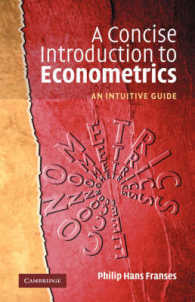- ホーム
- > 洋書
- > 英文書
- > Science / Mathematics
Full Description
Understanding and Designing Structures without a Computer: Spatial structural systems, dynamics and foundations explains fundamental concepts of structural analysis and design, providing readers with a clear understanding of the behaviour of a wide range of structural systems based on their load-carrying mechanisms.
The book employs a comprehensive qualitative and quantitative approach, supported by illustrative diagrams throughout. Clearly structured, the chapters guide readers from simple to complex concepts with new topics building on previous chapters. As a practical reference, this title equips readers with a solid understanding of universal structural principles, enabling safe conceptual and preliminary designs irrespective of the design code being used. It will also assist readers in interpreting and verifying computer-generated outputs.
This second volume in a two-book series delves into advanced topics such as spatial structural systems, dynamic behaviour, seismic response, and soil-structure interaction. It explores a wide range of subjects, including grillages, slabs, shells, rectilinear and curved thin-walled beams, rectilinear and curved box-girder bridges, and multi-storey systems. Additionally, it addresses the dynamic and seismic behaviour of structural systems, the performance of supporting structures on the ground, and soil-structure interaction.
Understanding and Designing Structures without a Computer: Spatial structural systems, dynamics and foundations is an accessible and authoritative resource for readers of all experience levels, fostering a solid understanding of structural behaviour without relying on computer models.
Contents
Preface
Introduction
Chapter 1 Grillages
Chapter 2 Slabs
Chapter 3 Shells
Chapter 4 Thin-walled beams
Chapter 5 Box Girders
Chapter 6 Lateral response of multistorey systems
Chapter 7 Dynamic behaviour of discrete mass systems
Chapter 8 Supporting structures on the ground








